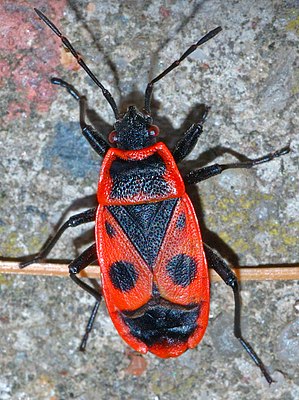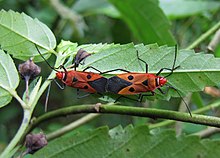Fire bugs
| Fire bugs | ||||||||||||
|---|---|---|---|---|---|---|---|---|---|---|---|---|

Common fire bug ( Pyrrhocoris apterus ) |
||||||||||||
| Systematics | ||||||||||||
|
||||||||||||
| Scientific name | ||||||||||||
| Pyrrhocoridae | ||||||||||||
| Amyot & Serville , 1843 |

The fire bugs (Pyrrhocoridae) are a family of the bugs (Heteroptera) within the suborder Pentatomomorpha . About 340 species in about 33 genera are known of them.
features
The bugs are 8 to 20 millimeters long and are often both in size and elongated body shape similar to species of the Lygaeinae (family: ground bugs (Lygaeidae)). Many species are colored in warning colors red, yellow, black, and white.
The head is triangular and directed forward. The bucculae , the cheek plates laterally delimiting the beak groove, are narrow. Pointed eyes ( Ocelli ) are absent as in the Largidae . The antennae and also the labium are four-part. The latter often extends well behind the base of the abdomen. The pronotum is trapezoidal and has flat flared margins. The scutellum is triangular. The outer part of the scent glands on the metathorax has receded. The membranes of the hemielytres have two cells at the base and seven or eight branching veins on the distal side . The second to seventh abdominal segment carries Trichobothria , with only two Trichobothria on the seventh segment, otherwise three. Similar to the Rhyparochromidae , in some species a curved seam runs between the fourth and fifth sternum on the abdomen, which does not extend to the dorsal edge of the abdomen. Inner laterotergites are missing. The spiracles lie ventrally on the abdomen . The sternum on the seventh abdominal segment of the females is undivided. The females have a receded, plate-shaped ovipositor . The spermatheca of the males lack the distal pump flange. The nymphs have their scent gland openings on the abdomen dorsally between the third to sixth tergum , with the rearmost openings being receded.
Autapomorphies of the family are the absence of the point eyes, the receding olfactory gland openings on the metathorax, the two closed cells basal on the membranes of the hemielytres and the plate-shaped ovipositor.
Occurrence
Representatives of the family are widespread in all major zoogeographical regions , but their main area of distribution is in the tropics and subtropics. Only a few species occur in the temperate latitudes of the Holarctic . Dysdercus is by far the largest genus in the family and is found worldwide.
In Europe, five species are represented, two of which occur in Central Europe. The German name "fire bug" results from the red and black warning costume of the most common Central European species of the family, the common fire bug ( Pyrrhocoris apterus ).
Way of life


Most of the species whose way of life is known feed on the seeds and fruits of the mallow family (Malvaceae). The Dysdercus species of the Neotropics feed on the seeds and fruits of wool tree plants (Bombacaceae). While there are some species whose adults live hidden in trees, most species live on low plants. Some species of the Old World live in the soil litter and presumably suckle on mature seeds that have fallen to the ground. Predatory ingestion of food has also been documented in the fire bugs. Presumably cannibalism also developed secondary from the originally phytophagous way of life. Dindymus sanguineus is one of those species that are known to also predate other insects. Occasional predatory suckling is known from at least several other Dindymus species, as well as the genera Raxa and Antilochus .
A number of species are known from West Africa that live in large colonies and have a complex way of life. These colonies often consist of more than one species and are also populated by predatory bugs (Reduviidae) of the genus Phonoctonus , which have adapted in their appearance to the respective fire bug species of the genus Dysdercus of the colonies. Dysdercus show migratory behavior. The survival rates and thus the spreading potential of larger species that suckle on woody plants and thus larger, oil-containing seeds are higher than with smaller ones that suckle on herbaceous plants. In most colony-forming Dysdercus species, the mated females resorb their flight muscles after the migration flight and the beginning of egg development, so that they can no longer change host plants. In the case of Dysdercus bimaculatus , it was observed that the females do not lose their flight characteristics before feeding and mating on the newly colonized host plant. This presumably means that the muscle resorption for a better supply of the eggs is in proportion to the risk of poor reproduction rates with unsuitable host plants. Some species of this genus live on ephemeral mallow plants, which are therefore only available to the bugs for a short time as food. However, since the females lay a large number of eggs in a short period of time, this gives a large number of nymphs the opportunity to develop at the right time.
Females live significantly shorter than males, which is probably due to the excessive strain involved in large egg production. This probably also results in the great sexual activity during which one can watch the fire bugs. Dysdercus species are considered to be important pests in agriculture, especially cotton . The damage is not only caused directly by sucking on the seed capsules, but also indirectly by the transfer of fungi and bacteria during sucking, which cause the capsules to die. In addition, Dindymus versicolor is considered a pest of little importance in orchards.
A number of fire bug species, e.g. B. the common fire bug and Dysdercus species, because of their simple keeping under artificial conditions, are used as experimental animals for research purposes.
Taxonomy and systematics
Even if the classification of fire bugs as a higher taxon is usually attributed to Franz Xaver Fieber (1861), it was Charles Jean Baptiste Amyot & Jean Guillaume Audinet Serville who first described the group in 1843 as "Pyrrhocorides". After the work of Carl Stål (1870, 1874) and subsequent authors, the family also comprised the Largidae family, which is now consistently regarded as an independent family , as a subfamily. The relationship within the fire bug family is unclear, a subdivision into subtaxa has not yet been established.
The following species occur in Europe:
- Common fire bug ( Pyrrhocoris apterus ) (Linnaeus, 1758)
- Pyrrhocoris marginatus (Kolenati, 1845)
- Pyrrhocoris niger Reuter, 1888
- Scantius aegyptius (Linnaeus, 1758)
- Scantius forsteri (Fabricius, 1781)
supporting documents
Individual evidence
- ↑ a b c d e Robert G. Foottit, Peter H. Adler: Insect Biodiversity: Science and Society . Wiley-Blackwell, New York 2009, ISBN 978-1-4051-5142-9 , pp. 248 .
- ↑ a b c d e Family Pyrrhocoridae. Australian Biological Resources Study. Australian Faunal Directory, accessed May 4, 2014 .
- ↑ a b c d e f g R. T. Schuh, JA Slater: True Bugs of the World (Hemiptera: Heteroptera). Classification and Natural History. Cornell University Press, Ithaca, New York 1995, pp. 270ff.
- ↑ a b Pyrrhocoridae. Fauna Europaea, accessed May 4, 2014 .
- ^ A b c Ekkehard Wachmann , Albert Melber, Jürgen Deckert: Bugs. Volume 3: Pentatomomorpha I: Aradoidea (bark bugs), Lygaeoidea (ground bugs, etc.), Pyrrhocoroidea (fire bugs) and Coreoidea (edge bugs, etc.). (= The animal world of Germany and the adjacent parts of the sea according to their characteristics and their way of life . 78th part). Goecke & Evers, Keltern 2007, ISBN 978-3-937783-29-1 , p. 193 ff .
literature
- RT Schuh, JA Slater: True Bugs of the World (Hemiptera: Heteroptera). Classification and Natural History. Cornell University Press, Ithaca, New York 1995.

